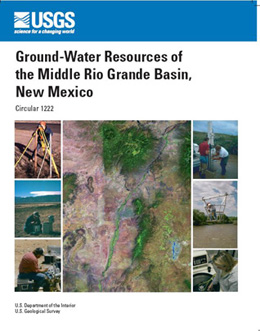 |
GROUND-WATER RESOURCES OF THE MIDDLE RIO GRANDE BASINWater-Resources Circular 1222By James R. Bartolino and James C. Cole |
 |
GROUND-WATER RESOURCES OF THE MIDDLE RIO GRANDE BASINWater-Resources Circular 1222By James R. Bartolino and James C. Cole |
The full report is available in pdf. Links to the pdf.
The Middle Rio Grande Basin covers approximately 3,060 square miles in central New Mexico, encompassing parts of Santa Fe, Sandoval, Bernalillo, Valencia, Socorro, Torrance, and Cibola Counties. In this report, “Middle Rio Grande Basin” refers to the geologic basin defined by the extent of deposits of Cenozoic age along the Rio Grande from about Cochiti Dam to about San Acacia. In 2000, the population of the Middle Rio Grande Basin was about 690,000, or about 38 percent of the population of New Mexico (U.S. Census Bureau, 2001a, 2001b). In 1995, the New Mexico Office of the State Engineer declared the Middle Rio Grande Basin a “critical basin”; that is, a ground-water basin faced with rapid economic and population growth for which there is less than adequate technical information about the available water supply. Though the basin had been intensively studied for a number of years, important gaps remained in the understanding of the water resources of the basin. In an effort to fill some of these gaps, the U.S. Geological Survey (USGS) and other Federal, State, and local agencies began the Middle Rio Grande Basin Study, a 6-year effort to improve the understanding of the hydrology, geology, and land-surface characteristics of the basin.
Cover Description
Title Page
Back of Title Page
Foreword
Acknowledgments
Contents
Boxes
Conversions
Characteristics of the Middle Rio Grande Basin
Geology
Surface Water
Ground Water
Ground-Water Chemistry
Ground-Water-Flow Modeling
Chapter 1: Common questions about water resources in the Middle Rio Grande Basin 1.65MB
How much water do we have?
How much water do we use?
How long will our supplies last?
How effective are water conservation efforts in the area?
How rapidly are ground-water levels declining?
Is municipal and(or) industrial pumping lowering ground-water levels outside major metropolitan areas?
Have ground-water-level declines triggered land subsidence?
How will water chemistry affect the use of ground water?
How much water in the basin is appropriated?
How much water can be pumped from the aquifer system using the present infrastructure?
How interrelated are the ground-water and surface-water systems?
Chapter 2: The Middle Rio Grande Basin 3 MB
Physical characteristics
Climate
Major vegetation types
Human activities and water resources
Chapter 3: Geology of the Santa Fe Group aquifer system 4.17MB
The Rio Grande Rift
Geologic processes that shaped the aquifer system
How the basin has changed over geologic time
Three-dimensional form of the aquifer system today
Effect of faults on the aquifer system
Contribution of geophysical data to understanding the aquifer system
How the geologic model represents current interpretation of basin structure and stratigraphy
Chapter 4: The hydrologic system of the Middle Rio Grande Basin 3.73MB
Surface-water system
Surface-water quantity
Ground-water system
Ground-water-level declines
Aquifer productivity
Ground-water quantity
Water use in the basin
Water budgets
Major legal and institutional controls on water in the basin
Rio Grande Compact
San Juan-Chama Transmountain Diversion Project
Endangered species
Water appropriation
Chapter 5: How water moves through the aquifer system 4.72 MB
Recharge and underflow—How ground water enters the aquifer system
Mountain-front recharge
Tributary recharge
Rio Grande and inner-valley recharge
Subsurface recharge or underflow
Flow paths—How ground water moves through the aquifer system
Discharge—How ground water leaves the aquifer system
Pumpage
Seepage to drains and the Rio Grande and springs
Evapotranspiration
Underflow
Effects of ground-water withdrawals
Deterioration of water quality
Water-well problems
Subsidence
Chapter 6: Chemical characteristics of water in the aquifer system 1.27MB
General quality of ground water and what it reveals about the ground-water system
Naturally occurring substances that limit the use of ground water
Contaminants of human origin and ground water
Chapter 7: Computer simulations of the aquifer system 2.86MB
Ground-water-flow model of the basin
Information used in the ground-water-flow model
What the ground-water-flow model tells us about the hydrologic system of the basin
What the ground-water-flow model tells us about future conditions
How much water is pumped where and by whom?
What are the availability and quality of water in deeper parts of the aquifer?
How much water does vegetation in the bosque use?
How is the aquifer responding to pumping over the long term?
Is septic-system effluent contaminating ground water?
How will the more stringent arsenic standard affect water supplies?
Are pharmaceuticals present in ground or surface water?
Chapter 9: Key points regarding water resources of the Middle Rio Grande Basin 829KB
Abbreviations and Chemical Notation
Prefixes for Abbreviations for Multiples and Submultiples 24KB
The text and graphics are presented here in pdf format:
The report is also available in sections below in pdf, for a faster download.
If you have Adobe Acrobat Reader installed on your computer, you may view and/or print the PDF version of this report. If you do not have Acrobat Reader, you may download it here.
Free on application to the:
U.S. Geological Survey,
Denver Federal Center
Information Services
Box 25286,
Denver, CO 80225
| AccessibilityFOIAPrivacyPolicies and Notices | |
 |
|